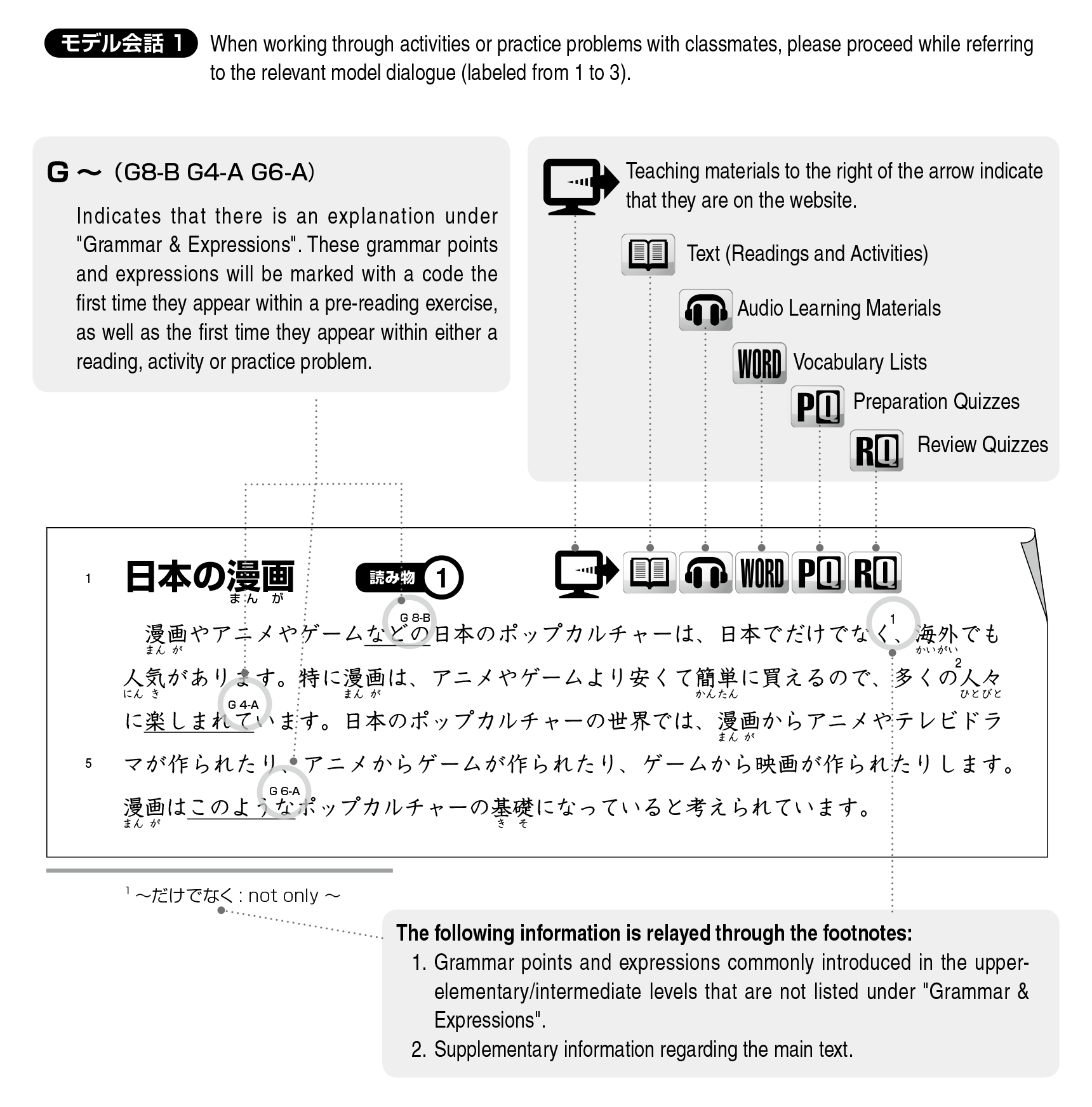I. The Overall Structure of POP CULTURE NEW & OLD
II. Symbols Used in the Textbook
III. How to Use This Textbook
IV. Self-Evaluation
V. Kanji Furigana (Phonetic Guides)
I. The Overall Structure of POP CULTURE NEW & OLD
The curriculum of POP CULTURE NEW & OLD combines the content of the physical textbook with materials found on the website (www.learnjpcinjapanese.com). The structure of the textbook and supplemental online learning material is outlined below.
1. Each Chapter’s Main Contents
For information on how this main content can be used to study, refer to “III. How to Use This Textbook“.
In the Textbook and on the Website
- Pre-Reading Activities (Before starting the main text)
Preparation tasks for reading the main text.
- Main Text (Readings and activities)
Readings related to the topic of each chapter along with various activities designed to further comprehension.
Only in the Textbook
- Practice Problems
Post-reading practice problems, such as comprehension checking problems, true or false problems, problems that require you to correct mistakes in a text, problems that involve summarizing information and activities that involve discussing related topics. - Images, Illustrations, Charts, etc.
Visual learning materials needed for reading comprehension, practice problems, etc. (They are indicated as “” on the website.) - Vocabulary Lists
Vocabulary lists for each reading and activity, sorted in Japanese alphabetical order. Translations are provided in English, Chinese, Korean and Vietnamese.
Only on the Website
- Audio Learning Materials
Audio materials for each reading, activity and vocabulary list that can be either played on the website or downloaded in mp3 format. - Vocabulary Lists (Separated by JLPT levels)
Vocabulary lists for each reading and activity, divided by Japanese Language Proficiency Test (JLPT) level. - Preparation Quizzes
Online quizzes designed to prepare learners for classroom lessons. - Review Quizzes
Online quizzes designed to review what was learned in class.
2. Other Contents
In the Textbook and on the Website
- Projects
Project work designed to lead up to an end-of-term presentation. - Model Dialogues
Model dialogues to be used when working on activities and practice problems. These dialogues follow one of three different patterns, and should be used as reference for in-class conversation. - Grammar & Expressions
Explanations of grammar points and expressions that are frequently used throughout the upper-elementary/lower-intermediate material. - Primary References
A list of books, documents and other materials used as references when creating the text.
Only in the Textbook
- English Translations of “Grammar & Expressions” Sample Sentences
English translations of “Grammar & Expressions” sample sentences that can only be found in the textbook. Try reading the sample sentences on the website first, and then check the textbook to see if your interpretation was correct.
Only on the Website
- Prerequisite Grammar & Expressions
Explanations of primarily lower-elementary level grammar and expressions that the learner should already be aware of at the time of reading the text. - Blog Articles
Various blog articles relating to the topics found within the textbook. - Instructor’s Manual
Information, lesson plans for each chapter and supplemental classroom materials to help design a course using this textbook.
[IMPORTANT]How to Use the Textbook and Website
The readings contained within this textbook can also be viewed on the website, allowing for the use of online and pop-up dictionaries. However, the final goal of this textbook is for learners to reach a point at which they can read the text without needing a dictionary. In order to achieve this goal, always try to use the physical textbook for reading, and use the website only when looking up certain definitions or kanji readings within a given text.
II. Symbols Used in the Textbook
III. How to Use This Textbook
1. Preparations before you begin learning with this textbook
In order to effectively proceed in learning with this textbook, first read “Features of the Textbook” and “Students’ Guide to Using Pop Culture New & Old“, and then try to do the following two things:
① Try out some reading support tools to help with reading the main texts (readings and activities) of this textbook.
This textbook is designed so that main texts can also be viewed on the website, enabling learners to quickly look up vocabulary and kanji using reading support tools such as pop-up dictionaries. For those who have never used a reading support tool before, please read the “Reading Support Tools” page on the website and try out the recommended applications. Even if you have used a reading support tool before, it is still recommended to check the page to see if there is a more convenient tool available.
Warning: Relying on reading support tools to translate sentences is not allowed!
If correctly used, the reading support tools are useful for improving reading comprehension skills. However, relying on a computer to translate entire sentences undermines the purpose of studying Japanese. Some reading support tools with pop-up dictionary functions have sentence and paragraph translation functions, but, while learning with this textbook, please use the reading support tools primarily for looking up vocabulary, expressions and kanji. It is important that you analyze the grammatical components (sentence structures, roles of particles, conjugations, tenses, etc.) yourself. Please be sure to differentiate between the helpful and unhelpful ways to use the reading support tools in your studies.
② Review the prerequisite grammar and expressions.
The reading materials in this textbook have been written under the assumption that the learner has already acquired the grammar and expressions listed on the “Prerequisite Grammar & Expressions” page on the website. These are the fundamental grammar points and expressions usually introduced in the early stages of the elementary level. Please review the items on this page. If you encounter any grammar points or expressions that you do not know, read over the explanations and sample sentences before proceeding.
2. “Pre-Reading Activities”
Before reading the main text of a chapter, use the “Pre-Reading Activities” to help prepare you for that chapter’s learning objectives. These activities include exercises such as thinking about one’s own experiences in the context of the chapter’s main topics, looking up vocabulary that will appear in the main text and developing an understanding of the necessary background material.
3. Reading the Main Texts (Readings and Activities)
To help learners maintain their motivation and enthusiasm, this textbook is organized in such a way that the main texts in each chapter are divided into smaller paragraph units, each of which is followed by its own practice problems. Please follow the outline below as you advance through the learning process.
3-1. Preparing Before Class
For effective learning with this textbook, it is essential for learners to read the designated text themselves before class. Please follow the three steps shown below to prepare for each class.
Activity 1
[Activity Content]
Read the paragraph(s) to be studied in class.
[Learning Objective]
Grasp the meaning of the text by using reading support tools (such as online or pop-up dictionaries) to quickly look up vocabulary and kanji.
Activity 2
[Activity Content]
Take the “Preparation Quiz” on the website.
[Learning Objective]
Attain a deeper understanding of the material by reading the text again while thinking about the answers to the quiz questions. (Preparation quizzes are automatically graded.)
Activity 3
[Activity Content]
Once an understanding of the text is achieved, examine the JLPT-based vocabulary list on the website and memorize as much of the vocabulary as possible. Then, try reading the text again without using a dictionary.
[Learning Objective]
Promptly and accurately read the text without the use of a dictionary.
3-2. While in Class
In class, follow the teacher’s instructions to proceed through the lesson. For effective classroom learning, make sure to follow the steps listed above to prepare well for each class. When answering post-reading practice problems, discuss with your classmates using model dialogues.
3-3. Studying After Class
Activity 1
[Activity Content]
Read the text once again and summarize the important points studied during class.
[Learning Objective]
Develop the ability to independently summarize important points in the text.
Activity 2
[Activity Content]
Check to make sure you understand all of the vocabulary words for your desired JLPT level by once again reviewing the JLPT-based vocabulary list on the website.
[Learning Objective]
Memorize all of the vocabulary for the desired JLPT level.
Activity 3
[Activity Content]
Listen to the audio recording of the text and check your understanding. If there are any parts you do not understand, reread those sections and listen to the audio again.
[Learning Objective]
Understand the content through listening alone, without reading or using a dictionary.
Activity 4
[Activity Content]
Take the “Review Quiz” on the website as a final step to check your understanding of the text and vocabulary. Continue attempting the quiz until you can answer the questions quickly without using a dictionary.
[Learning Objective]
Acquire an even deeper understanding of the text and master the vocabulary, grammar points and expressions contained therein. (Review quizzes are automatically graded.)
IV. Self-Evaluation
Upon completion of each reading and activity, conduct a self-evaluation by seeing if you can complete the tasks listed under “Learning Outcomes”.
V. Kanji Furigana (Phonetic Guides)
1. Main Text (Readings and Activities)
As a general rule, furigana readings are not provided if the vocabulary level and kanji level of each character in a word falls within JLPT level N4 or N5 (levels 3 and 4 in the former JLPT). In all other cases, and for words that have special readings, furigana is provided.
Examples:
- 「有名」Vocabulary Level N5, Kanji Levels「有」N4,「名」N5 → No Furigana
- 「子供」Vocabulary Level N5, Kanji Levels「子」N5,「供」N3 → Furigana Provided
- 「学者」Vocabulary Level N3, Kanji Levels「学」N5,「者」N4 → Furigana Provided
- 「大人」Vocabulary Level N5, Kanji Levels「大」N5,「人」N5 → Furigana Provided (due to special reading)
However, furigana readings are provided for all of the kanji below.
- Kanji used in proper nouns.
- Kanji within the activities before “Reading 1” of each chapter.
2. Pre-Reading Activities, Practice Problems, Projects, Model Dialogues and Grammar & Expressions
Furigana readings are provided for all kanji in these sections.


